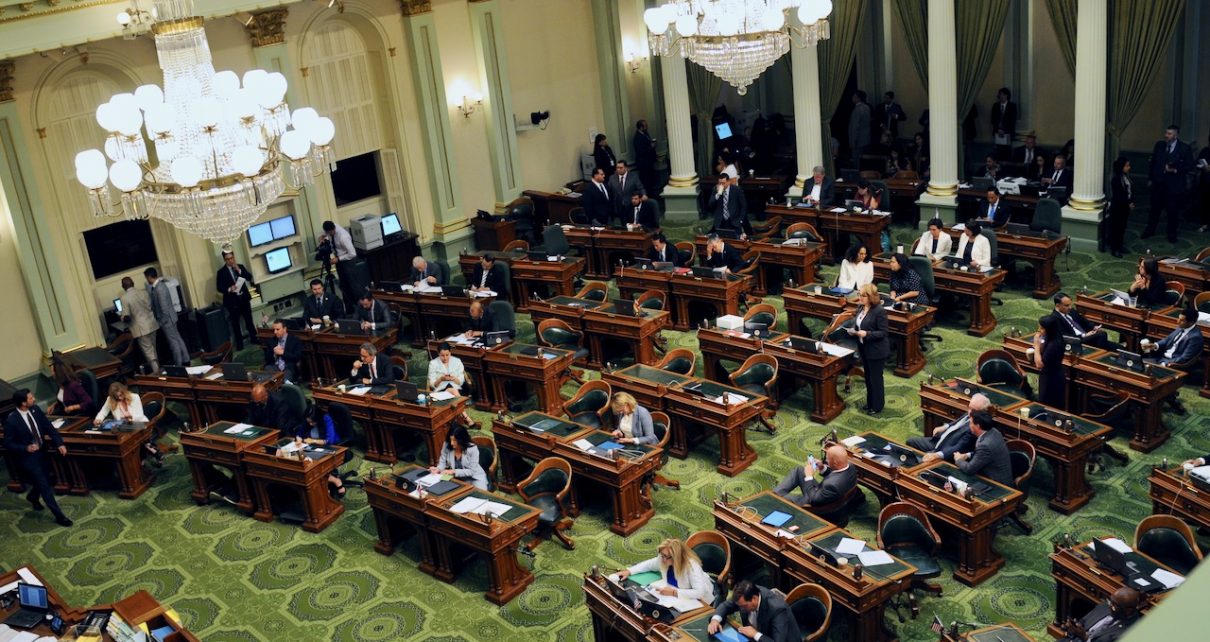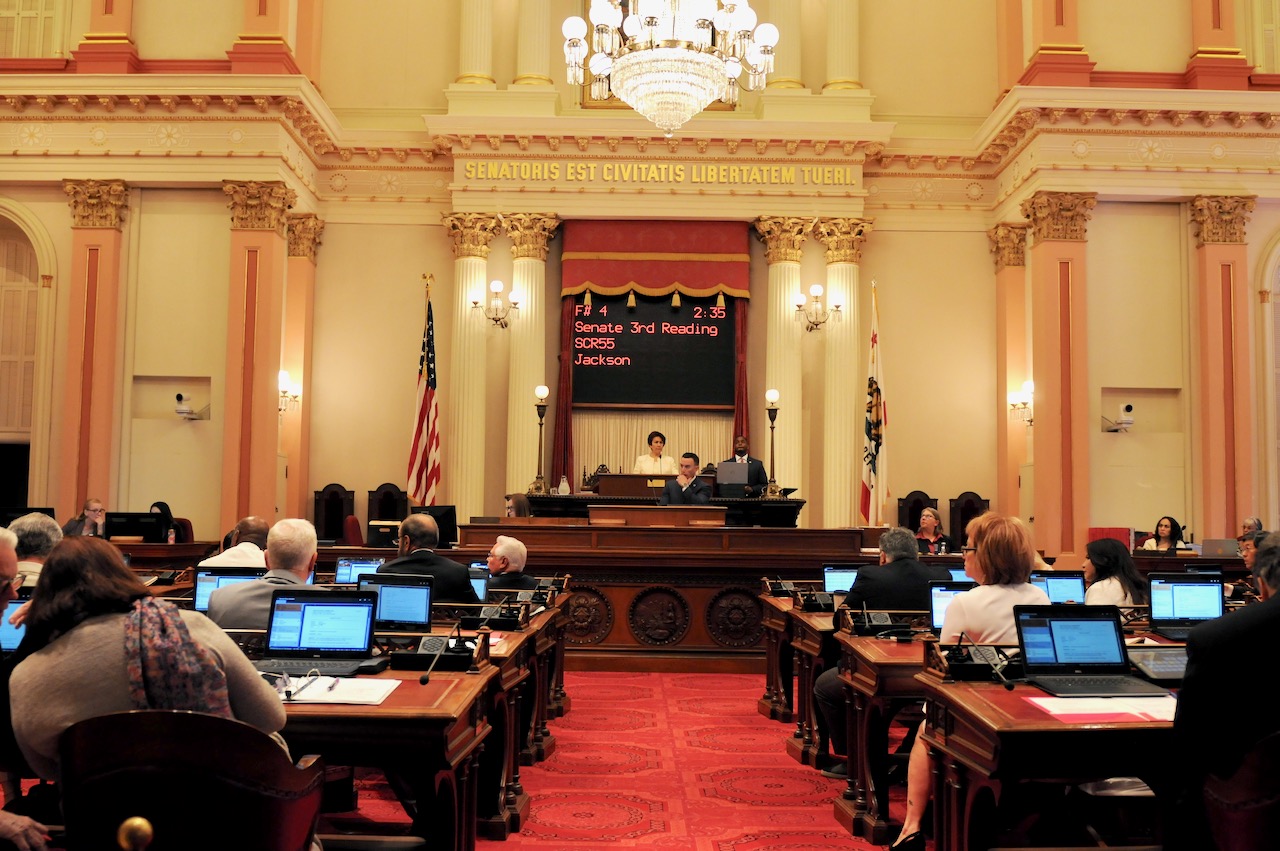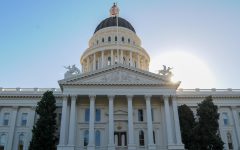
California State Assembly Chamber. (Photo: Kevin Sanders for California Globe)
Unique Provisions of California’s Budget Bill – Part I
These provisions of the state budget bill contain a lot of important information
By Chris Micheli, October 22, 2022 5:07 pm
The California state budget is the largest in the nation, and it also represents the largest bill in page length and number of provisions. While its provisions are too many to cover, there are a number of them that are unique and readers should be aware of them. This article is the first in a series.
So, what are some of these unique provisions of California’s Budget Bill?
Title
The Title of each California bill contains a statement of what the bill does (amend, add, repeal, or a combination of those) to one or more sections of one or more of the 29 Codes, combined with the “relating clause” (generally the subject matter of the bill). The California Budget Bill’s Title is different, as follows:
An act making appropriations for the support of the government of the State of California and for several public purposes in accordance with the provisions of Section 12 of Article IV of the Constitution of the State of California, relating to the state budget, to take effect immediately, budget bill.
Legislative Counsel’s Digest
The Legislative Counsel’s Digest is required in every bill upon the bill’s introductions with an objective explanation of existing law and what this bill would do. The first paragraph always begins with “Existing law….” And the next paragraph always begins with “This bill would…” In the annual budget bill’s Digest, there is no statement of existing law (because the budget is an uncodified statute that is changed each year). The California Budget Bill’s Digest is as follows:
This bill would make appropriations for the support of state government for the 2022–23 fiscal year.
This bill would declare that it is to take effect immediately as a Budget Bill.
DIGEST KEY
Vote: majority Appropriation: yes Fiscal Committee: yes Local Program: no
Named Act
On occasion, bills in the California Legislature are named acts. That occurs with the annual budget bill. The California Budget Bill’s naming is as follows:
SECTION 1.00.
This act shall be known and may be cited as the “Budget Act of 2022.”
Explanatory Provisions
In only the state budget bill are there explanatory provisions, along with a statement of legislative intent, about the format and style of what is contained in the bill. There are several provisions of the Government Code applicable to this area of the budget bill, including the following:
Title 2, Division 3, Part 3, Chapter 3, Article 3 (“Revised Budgeting and Accounting System for Fiscal Affairs of State Government”) includes Section 13338:
(a) The Budget Bill shall utilize a coding scheme compatible with the Governor’s Budget and with the records of the Controller.
(b) The Budget Bill shall provide for the appropriation of federal funds received by the state and deposited in the State Treasury.
Article 3 also includes Section 13344:
(a) State agencies shall prepare and maintain financial and accounting data for inclusion in the Governor’s Budget, Budget Act and related documents, and the budgetary-legal basis annual report described in Section 12460, according to the methods and bases provided in regulations, budget letters, and other directives of the Department of Finance.
The California Budget Bill contains the following as a customary introductory section:
SEC. 1.50.
(a) In accordance with Sections 12460, 13338, and 13344 of the Government Code, it is the intent of the Legislature that this act and other financial transactions authorized outside of this act utilize a coding scheme or structure compatible with the Governor’s Budget, the records of the Controller in legacy systems, and the Financial Information System for California (FI$Cal), and provide for the appropriation of federal funds received by the state and deposited in the State Treasury.
(b) Essentially, the format and style are as follows:
(1) Appropriation item numbers have a structure which is common to all the state’s fiscal systems. The meaning of this structure is as follows:
2720—Business Unit (known as organization code in legacy systems, indicates the department or entity) (e.g., 2720 represents the Department of the California Highway Patrol)
001—Reference Code (indicates whether the item is from the Budget Act or some other source and its character (e.g., 001–100 represents state operations in the Budget Act))
0044—Fund Code (e.g., 0044 represents the Motor Vehicle Account, State Transportation Fund)
(2) Appropriation items are organized in Business Unit order.
(3) All the appropriation items, reappropriation items, and reversion items, if any, for each business unit are adjacent to one another.
(4) Federal funds received by the state and deposited in the State Treasury are appropriated in separate items.
(c) The Department of Finance may authorize revisions to the codes or structures used in this act or used in other spending authority outside of this act to provide compatibility between the codes or structures used in this act or in other spending authority outside of this act and those used in the Governor’s Budget, in the records of the Controller in legacy systems, and in FI$Cal.
(d) Notwithstanding any other law, the Department of Finance may revise the schedule of any appropriation made in this act or in other spending authority outside of this act where the revision is of a technical nature and is consistent with legislative intent. These revisions may include, but shall not be limited to, the distribution of any unallocated amounts within an appropriation and the adjustment of schedules to facilitate departmental accounting operations. These revisions shall include a certification that the revisions comply with the intent and limitation of expenditures as appropriated by the Legislature.
(e) Notwithstanding any other law, and in accordance with legislative intent, the Department of Finance may authorize technical changes or corrections in FI$Cal or the Controller’s legacy systems resulting from or related to the conversion or implementation of FI$Cal for the current or past fiscal years, including, but not limited to, any of the following:
(1) Corrections to errors inadvertently created during the data conversion process from legacy systems into FI$Cal.
(2) Corrections or changes related to renumbering of programs and capital outlay projects. FI$Cal requires a different numbering scheme for the programs, elements, components, and tasks and projects. A new set of numbers is being utilized in FI$Cal different from what is reflected in prior budget acts and other authorizing sources. A comprehensive crosswalk facilitates the translation from programs, elements, components, and tasks to programs and subprograms and projects.
(3) Corrections or changes necessary to ensure compatibility among the legacy systems of the Controller and departments, and with that of FI$Cal. Multiple coding systems and structures (or chart of accounts) are being utilized during the transition period and until all departments and the Controller’s control functions are fully implemented in FI$Cal.
As the reader can see, these provisions of the state budget bill contain a lot of important information. For example, a consistent “coding scheme” is used in all budget-related acts, including the appropriation of federal funds.
- Interstate Depositions and Discovery Act - December 7, 2025
- Trial by the Court in California - December 7, 2025
- Enforcement of Labor Commissioner Judgments - December 6, 2025





One thought on “Unique Provisions of California’s Budget Bill – Part I”